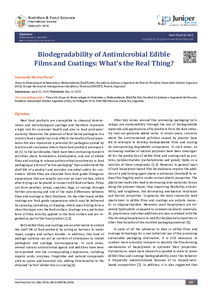Por favor, use este identificador para citar o enlazar este ítem:
https://repositorio.uca.edu.ar/handle/123456789/9911| Campo DC | Valor | Lengua/Idioma |
|---|---|---|
| dc.contributor.author | Pérez, Leonardo Martín | es |
| dc.date.accessioned | 2020-05-07T18:23:51Z | - |
| dc.date.available | 2020-05-07T18:23:51Z | - |
| dc.date.issued | 2019 | - |
| dc.identifier.citation | Pérez, L. M. Biodegradability of antimicrobial edible films and coatings: what's the real thing? [en línea]. Nutrition & Food Science International Journal. 2019, 8(5). Diponible en: https://repositorio.uca.edu.ar/handle/123456789/9911 | es |
| dc.identifier.issn | 2474-767X | - |
| dc.identifier.uri | https://repositorio.uca.edu.ar/handle/123456789/9911 | - |
| dc.description.abstract | Abstract: Opinion Most food products are susceptible to chemical deterioration and microbiological spoilage and therefore represent a high risk for consumer health and also to food producers’ economy. Moreover, the presence of food-borne pathogens in a country food-supplier not only affects the health of local population but also represents a potential for pathogens spread by tourists and consumers where these food products are exported [1]. In the last decades, there have been increasing research activities about formulation, development, and use of edible films and coating to release antimicrobial constituents in food packaging as a form of “active packaging” that could extend the shelf-life of a product and provides microbial safety for consumers. Edible films are obtained from food grade filmogenic suspensions that are usually cast over an inert surface, which after drying can be placed in contact with food surfaces. Films can form pouches, wraps, capsules, bags, or casings through further processing and one of the main differences between films and coatings is their thickness. On the other hand, edible coatings are food grade suspensions which may be delivered by spraying, spreading, or dipping, which upon drying form a clear thin layer over the food surface. Coatings are a particular form of films directly applied to the food surface and are regarded as part of the final product | es |
| dc.format | application/pdf | es |
| dc.language.iso | eng | es |
| dc.publisher | Juniper Publishers | es |
| dc.rights | Acceso abierto | * |
| dc.rights.uri | http://creativecommons.org/licenses/by-nc-sa/4.0/ | * |
| dc.source | Nutrition & Food Science International Journal. 2019, 8(5) | es |
| dc.subject | BIODEGRADACION | es |
| dc.subject | ALIMENTOS | es |
| dc.subject | PRODUCCION AGRICOLA | es |
| dc.subject | ECONOMIA REGIONAL | es |
| dc.subject | SALUD | es |
| dc.subject | ORGANISMOS PATOGENOS | es |
| dc.title | Biodegradability of antimicrobial edible films and coatings : what's the real thing? | es |
| dc.type | Artículo | es |
| uca.disciplina | INGENIERIA EN ALIMENTOS | es |
| uca.issnrd | 1 | es |
| uca.affiliation | Fil: Pérez, Leonardo Martín. Pontificia Universidad Católica Argentina. Facultad de Química e Ingeniería del Rosario; Argentina | es |
| uca.affiliation | Fil: Pérez, Leonardo Martín. Consejo Nacional de Investigaciones Científicas y Técnicas; Argentina | es |
| uca.version | publishedVersion | es |
| item.languageiso639-1 | en | - |
| item.fulltext | With Fulltext | - |
| item.grantfulltext | open | - |
| crisitem.author.dept | Facultad de Química e Ingeniería del Rosario | - |
| crisitem.author.dept | Instituto de Investigaciones en Ingeniería Ambiental, Química y Biotecnología Aplicada (INGEBIO) | - |
| crisitem.author.orcid | 0000-0002-4125-3536 | - |
| crisitem.author.parentorg | Pontificia Universidad Católica Argentina | - |
| crisitem.author.parentorg | Facultad de Química e Ingeniería del Rosario | - |
| Aparece en las colecciones: | Artículos | |
Ficheros en este ítem:
| Fichero | Descripción | Tamaño | Formato | |
|---|---|---|---|---|
| biodegradability-antimicrobial-edible-films.pdf | 340,57 kB | Adobe PDF |  Visualizar/Abrir |
Visualizaciones de página(s)
108
comprobado en 30-abr-2024
Descarga(s)
63
comprobado en 30-abr-2024
Google ScholarTM
Ver en Google Scholar
Este ítem está sujeto a una Licencia Creative Commons

